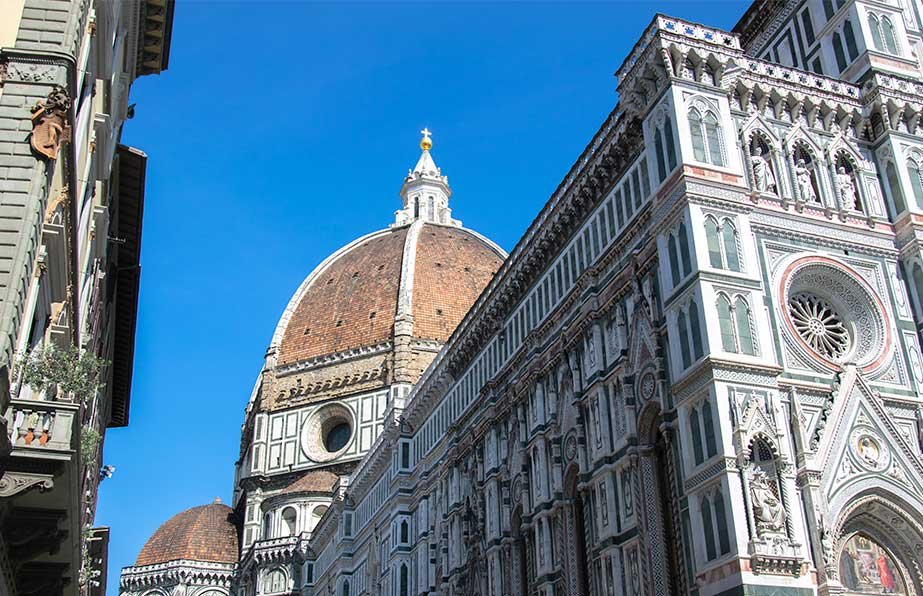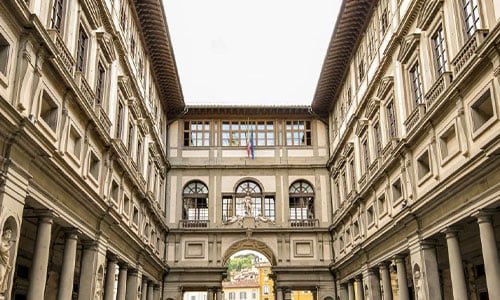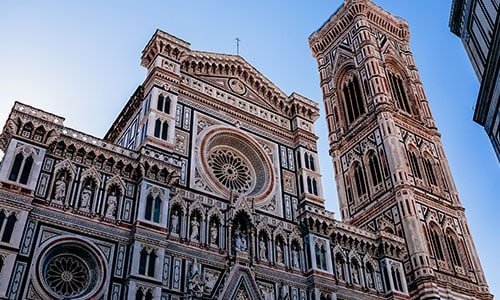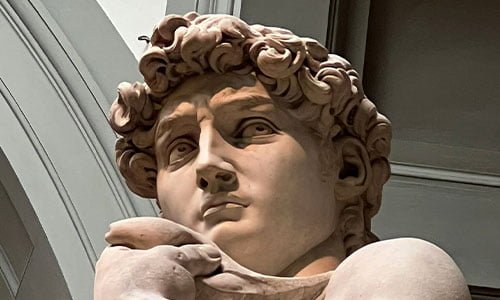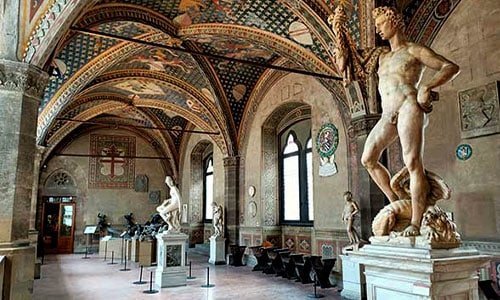santa croce florence
The Basilica di Santa Croce Florence considered the Florentine Pantheon of historic Italian figures, is a treasure trove of artistic wonders. Let’s visit it to discover its history and curiosities.
History of the Santa Croce Florence
where is santa croce in florence
Located in the square of Santa Croce, the basilica boasts a long history that began in the 1200s with the arrival of Saint Francis in Florence. The first Franciscan oratory was built outside the city walls, in a marshy area surrounded by the Arno River.
Over the centuries, the original church was renovated many times to accommodate the increasing number of worshippers.
The current church was designed by Arnolfo di Cambio, who was already working on the cathedral and Palazzo Vecchio. In 1294, construction began with the apse so that the previous church could continue to be used, allowing uninterrupted religious services.
Wealthy Florentine families and the general public funded the construction of the building. Despite various setbacks, such as the flood of 1302, the basilica was consecrated by Pope Eugene IV in 1443.
Adjacent to the basilica, various additions were made, including the Sacristy, dormitory, infirmary, refectory, and library. The religious complex is adorned with artistic works, thanks to donations from wealthy families and trade guilds. Over time, the Basilica di Santa Croce became a creative workshop, a theological center, and a Pantheon of Italian glories.
The flood of 1966 submerged Florence in mud, causing the loss of many works of art. Santa Croce Florence became a symbol of both the disaster and the city’s rebirth.
Architecture of the Santa Croce Florence

The Basilica di Santa Croce Florence is dedicated to the True Cross, believed to be the one upon which Jesus was crucified. It took seven centuries to transform this Neo-Gothic church into its present-day form.
Situated on an elevated position about the square, the basilica’s facade remained unfinished until 1863 and resembled San Lorenzo‘s. It was adorned only with a Christ emblem, created following the plague of 1437. Above the portal, in the niche, stood the gilded bronze statue of Saint Louis of Toulouse, a work by Donatello now housed in the convent museum.
The facade, covered with colored and precious marble, was designed by Niccolò Matas, drawing inspiration from the Orvieto Cathedral. Much of the funding for the work came from a wealthy English Protestant, Sir Francis Joseph Sloane.
The three lunettes of the portals depict the legend of the True Cross and represent the Finding of the Cross, the Triumph of the Cross, and the Vision of Constantine. The wooden doors were initially located in Santa Maria del Fiore, also known as the Duomo, until 1903.
Compared to the rich facade, the lateral facades of the Basilica di Santa Croce Florence are rather plain. The pietraforte, a sandstone, forms the background for the triangular tympanums and the two-light windows. The gutters take the shape of human and lion heads.
The fourteenth-century entrance on the left side, also known as Pinzochere, features coats of arms and funerary monuments embedded in the walls. The entrance and ticket office are located on this side of the church.
The bell tower is also situated in the apse area and has been rebuilt several times throughout history, often remaining unfinished. Only the base remained at one point, and the Florentines nicknamed it “masso di Santa Croce” (the mass of Santa Croce). Today, the bell tower has a tapering shape, with a height of 78.45 meters, and is decorated with a cornice around the pinnacle.
basilica of santa croce in Florence tickets Info
These are the prices of the various types of entrance tickets
| TICKET | PRICE | ENTITLED |
|---|---|---|
| Full ticket : | €8.00 | – |
| Reduced ticket : | €6.00 | Children aged 11 to 17, groups of at least 15 people, school groups |
| Free ticket : | – | Children under 11, residents of Florence and its province, disabled people and their companions, authorized tour guides, authorized tour leaders, teachers accompanying school groups |
| Family ticket : | €8.00 | Free for minors |
| Audio guide | €4.00 | – |
Note – By purchasing one of these tickets it is possible to visit the whole Monumental Complex of Santa Croce, which includes: the Museum, the Basilica, the Cloisters and the Pazzi Chapel.
You can get more details about Florence Santa Croce tickets and other options by clicking this link
basilica of santa croce in Florence Skip the line tickets options
basilica of santa croce best Guided Tours
Here are some guided tours of Santa Croce offered by GetYourGuide
Interior Architecture of Santa Croce Florence
The interior of the Basilica di Santa Croce Florence is sober and spacious. Large pillars with octagonal bases mark the three aisles, while pointed arches recall the style of early Christian basilicas.
The church has a plan in the shape of an Egyptian cross, or T-shape, typical of conventual churches. The upper narthex softens the Gothic aspect of the building, a style not widely favored in Florence then. However, it also served the purpose of reinforcing the various architectural elements.
Also typical of Franciscan churches is the beamed ceiling, while the walls are plain. Initially, they were intended to be frescoed with scenes from sacred scriptures to instruct the illiterate population.
The chapels of wealthy Florentine families, who contributed to the basilica construction, occupy the entire transept. Great masters were responsible for their sumptuous frescoes and rich decorations.
MAIN CHAPEL OF SANTA CROCE
The Main Chapel of Santa Croce is inspired by those found in European Gothic churches. It has a strong vertical emphasis, with umbrella-like ribs in the vault and narrow stained glass windows with decorative motifs. The frescoes by Agnolo Gaddi, dating back to 1380, cover the walls up to the ceiling and depict the stories of the True Cross.
To the right of the High Altar are the Peruzzi Chapel and the Bardi Chapel, decorated by Giotto between 1320 and 1325. The frescoes narrate the stories of Saint John the Baptist, Saint John the Evangelist, and Saint Francis. Particularly noteworthy are the detailed facial expressions depicted on the characters.
The Baroncelli Chapel, located in the transept, consists of two bays adorned with frescoes by Taddeo Gaddi, a disciple of Giotto.
There is also the Castellani Chapel, while on the opposite side are the chapels of the Spinelli and Capponi families, the latter dedicated to the mothers of fallen soldiers.
The Ricasoli Chapel features frescoes from the early 19th century depicting the stories of Saint Anthony of Padua.
BARDI CHAPEL
The Bardi Chapel of Vernio, located at the head of the transept, is known for Donatello’s Crucifix. When Brunelleschi saw it, he criticized it, saying that the Christ figure looked rough and resembled a peasant. In response, the artist decided to create his own Crucifix to demonstrate his skill, and today it can be admired in the church of Santa Maria Novella.
NICCOLINI CHAPEL
The Baroque Niccolini Chapel stands out for its beautiful, fully decorated elliptical dome. The frescoes by Volterrano depict the Coronation of the Virgin, with four Sibyls in the corners. It is said that it was in this chapel that Stendhal experienced strong emotions, now known as the “Stendhal Syndrome.”
MEDICI CHAPEL
The Medici Chapel is reached by passing through Michelozzo’s portal, surmounted by a fresco depicting the Disputation of the Temple by Taddeo Gaddi. The chapel was commissioned by Cosimo de’ Medici and dedicated to the saints Cosmas and Damian, who are also depicted in the stained glass window.
This space was used by novices preparing to enter the Franciscan order. A cross vault dominates the chapel, while the glazed terracotta altarpiece portrays the Virgin in Majesty by Giovanni della Robbia. The works hanging on the walls come from other churches and convents that Napoleon suppressed in the 1800s.
santa croce florence mass times
| Mass on weekdays and on the eve of religious or public holidays | 6 pm |
| Mass on religious holidays New Year’s Day (1 January), Epiphany (6 January), Easter, Feast of St. Anthony of Padua (13 June), Assumption (15 August), Feast of St. Francis of Assisi (4 October), All Saints (1 November), Immaculate Conception (8 December), Christmas (24 December), Boxing Day (26 December). | 11 am and 6 pm |
| Confession Daily | 10-12 am and 4-6 pm |
| Recital of the Rosary From Monday to Friday | 5.30 pm |
| Prayer in front of Donatello’s Crucifix Daily | 15.30 |
SANTA CROCE SACRISTY
On the side of the corridor leading to the Medici Chapel, you will find the Sacristy, where religious objects are kept, and the Franciscans gather for important meetings.
Topped by a beamed ceiling, the room is wholly frescoed, and on one side, there is Taddeo Gaddi‘s Crucifixion, alongside other religious scenes.
The 15th-century antique furniture houses the vestments of the friars, which they wear before religious services.

In the Sacristy, you will also find Cimabue’s large Crucifix from 1288, a symbol of the flood that occurred on 4 November 1966. Despite meticulous restoration, sixty percent of the artwork was lost, but its magnificence remains.
The body of Christ appears less rigid than in previous paintings, giving it a more realistic portrayal through the chiaroscuro technique.
PANTHEON OF FLORENTINE SANTA CROCE
The floor and walls of Santa Croce Florence house over 270 marble tombstones adorned with reliefs and coats of arms. During the 19th century, the basilica became a Pantheon for illustrious Italian figures. Musicians, playwrights, writers, poets, politicians, and fighters from various eras are commemorated. Some have their remains preserved there, while others have cenotaphs, as they are buried elsewhere.
Who is buried in Santa Croce Florence?
One can find that of Dante Alighieri among the numerous monuments and cenotaphs. Since he was in exile in Ravenna, his tomb remains there, and in the basilica, there is only his cenotaph. Created in 1829, it features neoclassical allegories of Italy and Poetry.
The tomb of Michelangelo Buonarroti was designed by Vasari when his remains arrived from Rome in 1564. The allegories of Painting, Sculpture, and Architecture are depicted with mournful expressions, reflecting the loss of the master.
Leaned against a pillar in front of Michelangelo‘s tomb is the tomb of Francesco Nori, remembered for saving Lorenzo the Magnificent during the Pazzi Conspiracy at the Duomo. It is adorned with the sculpture of the Madonna of Milk.

In 1810, Antonio Canova created the monument to Vittorio Alfieri, a poet, playwright, and writer. The personification of Weeping Italy leans on the classical coffin, with a medallion depicting the artist’s profile.
The monument dedicated to Niccolò Machiavelli stands out for the allegory of Diplomacy, and a plaque commemorates Antonio Meucci, the telephone inventor.
The tomb of Galileo Galilei, buried with one of his disciples and his daughter Sister Maria Celeste, displays decorations with busts and personifications of Astronomy and Geometry.
Some burials are particularly unique. In the counter-façade with the rose window is the tomb of Giovan Battista Niccolini, surmounted by the personification of Liberty and Poetry. The sculpture bears a striking resemblance to the Statue of Liberty in New York.

There are many other burials and commemorative plaques, including that of Ugo Foscolo, who was an atheist, among other things.
what to see in santa croce florence
ARTWORKS IN SANTA CROCE FLORENCE
The aisles are also adorned with other artistic works. For example, Benedetto da Maiano’s pulpit stands out for its octagonal shape and comprises panels depicting perspective scenes and statuettes of virtues.
Also noteworthy is the tabernacle with Donatello‘s high relief of the Annunciation, created in 1435 in grey sandstone. Initially, the monument was likely white and imitated marble, with gilding added later.
Cloisters OF THE SANTA CROCE FLORENCE

In the Basilica of Santa Croce Florence, there are two cloisters. One is the Arnolfo Cloister, named after the first architect of the basilica, who also designed the refectory. The other is the Brunelleschi Cloister, which is square in shape and accessed through a portal bearing the coat of arms of a Florentine family.
The cloisters feature cypress trees and two statues. One statue depicts God the Father seated, by Baccio Bandinelli, and the other is a modern bronze statue by Henry Moore called “Warrior with Shield” from 1972, which was initially exhibited at Palazzo Vecchio.
CHAPEL OF THE PAZZI IN SANTA CROCE FLORENCE
The beautiful Pazzi Chapel overlooks the rectangular Arnolfo Cloister. It is considered a Renaissance masterpiece designed by Filippo Brunelleschi, who died before its completion.
Initially, the site housed the dormitory and library of the Santa Croce Florence convent, which were destroyed in a fire in 1423. The construction of the new chapter house was financed by the wealthy Florentine Pazzi family, who also built their private chapel there. Due to their conspiracy against the Medici family, they were exiled, and the work remained unfinished.
Although the initial design was by Brunelleschi, many other artists worked on it, making their own variations. The Pazzi Chapel is a masterpiece for its perfect proportions, harmonious forms, and sober and elegant appearance.
ARCHITECTURE OF THE PAZZI CHAPEL
The Pazzi Chapel is divided into three distinct areas: the portico, the main body, and the choir. The entrance resembles a Roman triumphal arch, with six Corinthian columns surmounted by an attic. In the middle stands the splendid small dome with polychrome glazed terracotta rosettes and Pazzi family coats of arms. Above the portal, with its carved wooden doors and floral reproductions, is the roundel of St. Andrew, the patron saint of the family who commissioned the chapel.
Externally, the dome culminates in a simple lantern, but it is on the inside that its beauty and simplicity are fully revealed. Resting on a drum with 12 small round windows, the dome is defined by 12 ribs.
The main body of the Pazzi Chapel forms a central cubic space, surmounted by the dome, with two rectangular side wings featuring barrel vaults. On the walls, 12 large glazed terracotta medallions depict the Apostles, and at the corners of the dome, four more roundels depict the Evangelists, all created by Luca della Robbia.
A stone bench runs along the perimeter, which was used by the friars when they gathered in the chapter house.

The altar is very simple, and instead of an altarpiece, there are two coloured stained glass windows. The dome above reproduces the constellations present over Florence on 4 July 1442. According to scholars, this could be when a condottiere (military leader) arrived in the city, departing for another crusade against the Ottomans in the Holy Land.
Il Refettorio di Santa Croce Florence, parte del Museo dell’Opera di Santa Croce, is one of the oldest in Florence and dates back to the 14th century. It houses many artistic treasures submerged under five meters of water during the 1966 flood. Even now, the water levels reached during different floods that affected Florence are indicated on the walls.
The Basilica of Santa Croce Florence was particularly affected by this natural disaster. During that time, Cimabue’s Crucifix was hanging in this room, but it is now preserved in the Sacristy.
TREE OF LIFE IN SANTA CROCE FLORENCE
On the back wall, you can find the fresco of the Tree of Life, composed of twelve branches adorned with medallions depicting the prophets. This work by Taddeo Gaddi, a student of Giotto, represents the Crucifixion and dates back to around 1350. The Last Supper is shown in the lower part.
The side walls of the refectory display fragments of frescoes by Andrea Orcagna, including the Triumph of Death, Hell, and the Last Judgment. They were discovered beneath the 16th-century plaster of the church nave, which Vasari possibly covered following the flood of 1557.
SAINT LUDOVIC OF TOULOUSE
The statue of Saint Ludovic of Toulouse, a work by Donatello from 1422, was initially exhibited in Orsanmichele. Later, it was placed on the façade of the Basilica of Santa Croce Florence, where it remained until 1510. The statue stands almost three meters tall and comprises ten gilded pieces assembled on a central structure.
Vasari’s painting of the Last Supper from 1546, initially located in a convent that was closed during the Napoleonic period, is also displayed in the refectory.
In the refectory, where you can also admire the beautiful beamed ceiling, the friars used to consume their meals in silence. However, over the centuries, the room has also served other purposes. It became a carpet factory, a warehouse, and now a beautiful museum.
USEFUL INFORMATION
Opening times – Opening hours are from 09.30 until 17.30 (with last entrance at 17.00) from Monday to Saturday, and from 14.00 to 17.00 on Sundays and certain holidays.
Ticket Price Full: 8€, Reduced: 6€
Holiday Closure
New Year’s Day (1 January), Easter, Feast of St. Anthony of Padua (13 June), Feast of St. Francis of Assisi (4 October), Christmaas Day (25 december), Boxing Day (26 December)
HOW TO GET THERE
Address: Piazza Santa Croce 16, 50122 – Florence – Italy
Read blog
Best way to visit Uffizi Gallery

Best way to visit Uffizi Gallery – valuable tips for visiting the Uffizi Gallery in Florence Visiting the Uffizi Gallery in Florence is a must-do experience in life. Here are our tips for thoroughly enjoying the visit. Giorgio Vasari designed The Uffizi Gallery in the mid-16th century to house Florence’s 13 most essential magistracies, known…
what to see in Florence in one day

what to see in Florence in one day: walking itinerary in the historical center What to see in Florence in one day. Itinerary on foot from Santa Maria Novella to Santa Croce, through the most characteristic neighborhoods of the Tuscan capital. Florence has always been one of my favorite Italian cities of art. Elegant, rich…
Florence’s Duomo has an ox’s head that no one noticed

Many beautiful sculptures decorate the façade as well as the sides of the world-renowned Cathedral of Santa Maria del Fiore in Florence, but they are often overlooked, particularly when viewed through a quick, unfocused glance. Booking.com One particular sculpture, which is likely to be not noticed by the majority of people, appears to be unnatural…
santa croce florence photos





